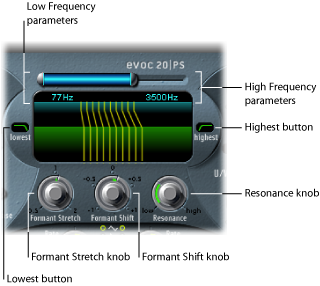EVOC 20 PolySynth Formant Filter Parameters
The EVOC 20 PolySynth features two formant filter banks—one for the Analysis section and one for the Synthesis section. Each bank can house up to 20 individual filters. In essence, the entire frequency spectrum of an incoming signal is analyzed by the Analysis section and divided equally into a number of frequency bands. These analysis filter bands are mirrored by a corresponding number of bands in the synthesis filter bank. Each filter bank controls the peak levels—the formants—within these frequency bands. For more information, see How Does a Vocoder Work?, and A Short Primer on Formants.
EVOC 20 PolySynth Formant Filter Parameters Overview
The Formant Filter display is divided in two by a horizontal line. The upper half applies to the Analysis section and the lower half to the Synthesis section. Parameter changes are instantly reflected in the Formant Filter display, providing invaluable feedback about what is happening to the signal as it is routed through the two formant filter banks.

- High and Low Frequency parameters: Determine the lowest and highest frequencies allowed to pass by the filter section. Frequencies that fall outside these boundaries will be cut.
The length of the horizontal blue bar at the top represents the frequency range for both analysis and synthesis (unless Formant Stretch or Formant Shift are used, as described below). You can move the entire frequency range by dragging the blue bar. The silver handles on either end of the blue bar set the Low Frequency and High Frequency values, respectively.
You can also drag vertically in the numeric fields to adjust the Low and High frequency values.
- Lowest and Highest buttons: Click to determine whether the lowest and highest filter bands act as bandpass filters—like all of the bands between them—or whether they act as lowpass or highpass filters, respectively.
- Lowest button: Click to determine whether the lowest filter band acts as a bandpass or highpass filter. In the Bandpass setting, the frequencies below the lowest bands and above the highest bands are ignored. In the Highpass setting, all frequencies below the lowest bands are filtered.
- Highest button: Click to determine whether the lowest filter band acts as a bandpass or lowpass filter. In the Bandpass setting, the frequencies below the lowest bands and above the highest bands are ignored. In the Lowpass setting, all frequencies above the highest bands are filtered.
- Formant Stretch knob: Alters the width and distribution of all bands in the synthesis filter bank. This can be a broader or narrower frequency range than that defined by the Low and High Frequency parameters. See Using EVOC 20 PolySynth Formant Stretch and Shift.
- Formant Shift knob: Moves all bands in the synthesis filter bank up or down the frequency spectrum. See Using EVOC 20 PolySynth Formant Stretch and Shift.
Using EVOC 20 PolySynth Formant Stretch and Shift
When Formant Stretch is set to 0, the width and distribution of the bands in the synthesis filter bank at the bottom matches the width of the bands in the analysis filter bank at the top. Low values narrow the width of each band in the synthesis filter bank, whereas high values widen the bands. The control range is expressed as a ratio of the overall bandwidth.
When Formant Shift is set to 0, the positions of the bands in the synthesis filter bank match the positions of the bands in the analysis filter bank. Positive values move the synthesis filter bank bands up in frequency, whereas negative values move them down—in respect to the analysis filter bank band positions.
When combined, Formant Stretch and Formant Shift alter the formant structure of the resulting vocoder sound, which can lead to some interesting timbre changes. For example, using speech signals and tuning Formant Shift up results in “Mickey Mouse” effects.
Formant Stretch and Formant Shift are also useful if the frequency spectrum of the synthesis signal does not complement the frequency spectrum of the analysis signal. You could create a synthesis signal in the high frequency range from an analysis signal that mainly modulates the sound in a lower frequency range, for example.
Note: The use of the Formant Stretch and/or the Formant Shift parameters can result in the generation of unusual resonant frequencies, when high Resonance settings are used.